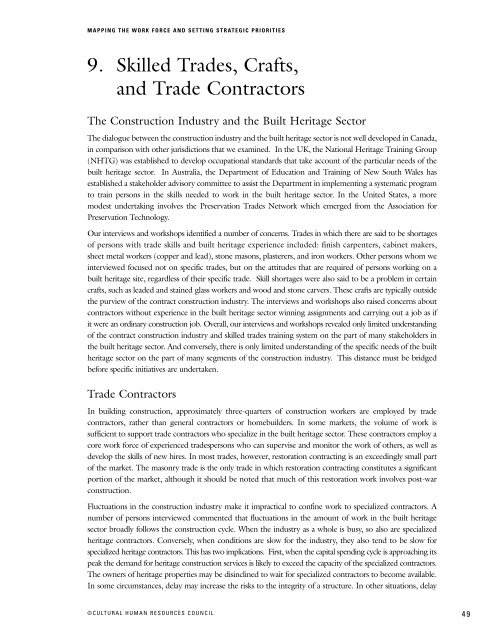Human Resources in Canada's Built Heritage Sector: Mapping the ...
Human Resources in Canada's Built Heritage Sector: Mapping the ...
Human Resources in Canada's Built Heritage Sector: Mapping the ...
- No tags were found...
Create successful ePaper yourself
Turn your PDF publications into a flip-book with our unique Google optimized e-Paper software.
MAPPING THE WORK FORCE AND SETTING STRATEGIC PRIORITIES9. Skilled Trades, Crafts,and Trade ContractorsThe Construction Industry and <strong>the</strong> <strong>Built</strong> <strong>Heritage</strong> <strong>Sector</strong>The dialogue between <strong>the</strong> construction <strong>in</strong>dustry and <strong>the</strong> built heritage sector is not well developed <strong>in</strong> Canada,<strong>in</strong> comparison with o<strong>the</strong>r jurisdictions that we exam<strong>in</strong>ed. In <strong>the</strong> UK, <strong>the</strong> National <strong>Heritage</strong> Tra<strong>in</strong><strong>in</strong>g Group(NHTG) was established to develop occupational standards that take account of <strong>the</strong> particular needs of <strong>the</strong>built heritage sector. In Australia, <strong>the</strong> Department of Education and Tra<strong>in</strong><strong>in</strong>g of New South Wales hasestablished a stakeholder advisory committee to assist <strong>the</strong> Department <strong>in</strong> implement<strong>in</strong>g a systematic programto tra<strong>in</strong> persons <strong>in</strong> <strong>the</strong> skills needed to work <strong>in</strong> <strong>the</strong> built heritage sector. In <strong>the</strong> United States, a moremodest undertak<strong>in</strong>g <strong>in</strong>volves <strong>the</strong> Preservation Trades Network which emerged from <strong>the</strong> Association forPreservation Technology.Our <strong>in</strong>terviews and workshops identified a number of concerns. Trades <strong>in</strong> which <strong>the</strong>re are said to be shortagesof persons with trade skills and built heritage experience <strong>in</strong>cluded: f<strong>in</strong>ish carpenters, cab<strong>in</strong>et makers,sheet metal workers (copper and lead), stone masons, plasterers, and iron workers. O<strong>the</strong>r persons whom we<strong>in</strong>terviewed focused not on specific trades, but on <strong>the</strong> attitudes that are required of persons work<strong>in</strong>g on abuilt heritage site, regardless of <strong>the</strong>ir specific trade. Skill shortages were also said to be a problem <strong>in</strong> certa<strong>in</strong>crafts, such as leaded and sta<strong>in</strong>ed glass workers and wood and stone carvers. These crafts are typically outside<strong>the</strong> purview of <strong>the</strong> contract construction <strong>in</strong>dustry. The <strong>in</strong>terviews and workshops also raised concerns aboutcontractors without experience <strong>in</strong> <strong>the</strong> built heritage sector w<strong>in</strong>n<strong>in</strong>g assignments and carry<strong>in</strong>g out a job as ifit were an ord<strong>in</strong>ary construction job. Overall, our <strong>in</strong>terviews and workshops revealed only limited understand<strong>in</strong>gof <strong>the</strong> contract construction <strong>in</strong>dustry and skilled trades tra<strong>in</strong><strong>in</strong>g system on <strong>the</strong> part of many stakeholders <strong>in</strong><strong>the</strong> built heritage sector. And conversely, <strong>the</strong>re is only limited understand<strong>in</strong>g of <strong>the</strong> specific needs of <strong>the</strong> buil<strong>the</strong>ritage sector on <strong>the</strong> part of many segments of <strong>the</strong> construction <strong>in</strong>dustry. This distance must be bridgedbefore specific <strong>in</strong>itiatives are undertaken.Trade ContractorsIn build<strong>in</strong>g construction, approximately three-quarters of construction workers are employed by tradecontractors, ra<strong>the</strong>r than general contractors or homebuilders. In some markets, <strong>the</strong> volume of work issufficient to support trade contractors who specialize <strong>in</strong> <strong>the</strong> built heritage sector. These contractors employ acore work force of experienced tradespersons who can supervise and monitor <strong>the</strong> work of o<strong>the</strong>rs, as well asdevelop <strong>the</strong> skills of new hires. In most trades, however, restoration contract<strong>in</strong>g is an exceed<strong>in</strong>gly small partof <strong>the</strong> market. The masonry trade is <strong>the</strong> only trade <strong>in</strong> which restoration contract<strong>in</strong>g constitutes a significantportion of <strong>the</strong> market, although it should be noted that much of this restoration work <strong>in</strong>volves post-warconstruction.Fluctuations <strong>in</strong> <strong>the</strong> construction <strong>in</strong>dustry make it impractical to conf<strong>in</strong>e work to specialized contractors. Anumber of persons <strong>in</strong>terviewed commented that fluctuations <strong>in</strong> <strong>the</strong> amount of work <strong>in</strong> <strong>the</strong> built heritagesector broadly follows <strong>the</strong> construction cycle. When <strong>the</strong> <strong>in</strong>dustry as a whole is busy, so also are specializedheritage contractors. Conversely, when conditions are slow for <strong>the</strong> <strong>in</strong>dustry, <strong>the</strong>y also tend to be slow forspecialized heritage contractors. This has two implications. First, when <strong>the</strong> capital spend<strong>in</strong>g cycle is approach<strong>in</strong>g itspeak <strong>the</strong> demand for heritage construction services is likely to exceed <strong>the</strong> capacity of <strong>the</strong> specialized contractors.The owners of heritage properties may be dis<strong>in</strong>cl<strong>in</strong>ed to wait for specialized contractors to become available.In some circumstances, delay may <strong>in</strong>crease <strong>the</strong> risks to <strong>the</strong> <strong>in</strong>tegrity of a structure. In o<strong>the</strong>r situations, delay©CULTURAL HUMAN RESOURCES COUNCIL49










